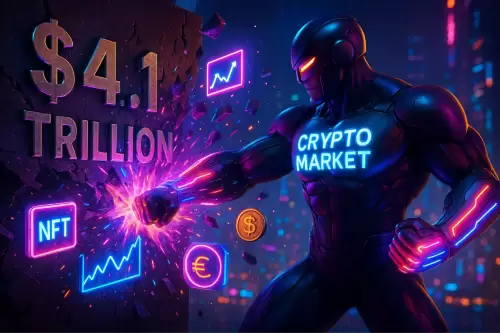 |
|
 |
|
 |
|
 |
|
 |
|
 |
|
 |
|
 |
|
 |
|
 |
|
 |
|
 |
|
 |
|
 |
|
 |
|
Cryptocurrency News Articles
Since the Pi Network mainnet launched on February 20, it has made headlines for its ambitious goals. Yet, it has also faced substantial criticism
May 19, 2025 at 06:30 pm
Since the Pi Network mainnet launched on February 20, it has made headlines for its ambitious goals. Yet, it has also faced substantial criticism.
Since its mainnet launch on February 20, Pi Network has been making headlines for its ambitious goals and facing substantial criticism.
With an impressive user base of reportedly 60 million, also known as Pioneers, keeping a close eye on its performance, Pi Network has come under scrutiny for its underwhelming price performance, lack of decentralized applications (dApps), and other issues.
This has raised questions about whether the project can meet the high expectations of its massive community.
Here are five key areas of underperformance that emerged as focal points for observers in early 2025.
1. Absence of Binance Listing Despite Community Vote
A primary concern among Pioneers was the lack of listing on major cryptocurrency exchanges, particularly Binance. In a February community vote, 86% of participants voted in favor of listing Pi Coin (PI).
However, despite this show of support, Binance, known for its stringent listing criteria, decided not to include PI.
On May 15, the exchange posted its logo on X (formerly Twitter) featuring several mathematical symbols, including π, sparking speculation among Pioneers. Still, no official listing announcement followed.
This is what happens when devs touch art with 0 design sense. pic.twitter.com/8kzFW8KcEM
— Binance (@binance) May 15, 2025
The absence of a listing led to renewed scrutiny over Pi Network’s credibility. Binance applies a rigorous evaluation process before listing any asset.
The exchange considers user adoption, business model viability, relevance, tokenomics, technical security, team background, and compliance with regulatory standards. The decision not to list Pi Coin may indicate that the project failed to meet one or more of these critical benchmarks.
“I now better understand why Pi is not listed on major exchanges such as Binance and Coinbase. It is likely that the Pi Core Team has not been transparent enough about the locking and burning mechanism involving the billions of Pi coins currently owned by the PCT,” Pioneer Dr. Altcoin posted on March 22.
Coinbase, another top exchange, also abstained from listing Pi, further fueling disappointment among Pioneers about the token’s potential for mainstream adoption. Nonetheless, Pi Coin is available for trading on HTX, Bitget, MEXC, and OKX.
2. Price Performance Fails to Impress
Pioneers have been actively mining Pi Coin for around six years, anticipating major gains. However, its price performance on exchanges was a letdown for many.
Upon launch, Pi Coin was listed on OKX with a floor price of just $2, a stark contrast to its IOU trading value, which reached several hundred dollars in 2023.
The underwhelming debut worsened as PI dipped below the $1 mark shortly after listing. While the token rebounded to an all-time high of $3 in late February, the rally was short-lived.
PI soon resumed its downtrend, falling below $1 again by late March. Last week, the level was briefly reclaimed as support. Yet once more, PI failed to hold above it.
These declines came despite some bullish catalysts. The launch of the Pi Ventures Fund was followed by a sharp price drop rather than a recovery. Additionally, Pi Network founder Nicolas Kokkalis made a rare public appearance at Consensus 2025 on May 16.
Many hoped it would restore investor confidence. Instead, the token plunged. BeInCrypto data showed that PI dipped 42.6% over the past week. At press time, Pi Coin’s price was $0.7, down 3.1% over the past day.
As reported by BeInCrypto, allegations of insider selling and concerns about a potential rug pull have further compounded investor worries.
3. Fate of the $100 Million Ventures Fund Remains Uncertain
On May 14, the Pi core team introduced Pi Network Ventures. The initiative aims to support startups building on the network.
While the official announcement mentions a funding pool of up to $100 million, Pi Network Foundation retains full discretion over the deployment of these funds.
“The Pi Foundation is not obligated to invest the entire $100 million, based on the quality of applicants and number of startups accepted into the initiative,” the blog stated.
The initiative also allows for phased investments over time. Additionally, the Foundation can discontinue funding at any stage. This condition has not been well received by some in the community, who expected more immediate and guaranteed support for ecosystem development.
“The $100M promise investment will discontinue from time to time if they don’t see any investors coming or having no impact at all LOL,” a user wrote.
4. Where Are the Decentralized Apps?
The concerns extend beyond the fund’s stability. Dr. Altcoin asserted that the team is busy building DApps, which should have already been completed.
He explained
Disclaimer:info@kdj.com
The information provided is not trading advice. kdj.com does not assume any responsibility for any investments made based on the information provided in this article. Cryptocurrencies are highly volatile and it is highly recommended that you invest with caution after thorough research!
If you believe that the content used on this website infringes your copyright, please contact us immediately (info@kdj.com) and we will delete it promptly.






























































